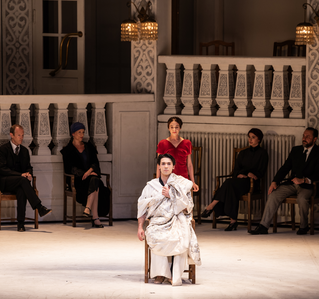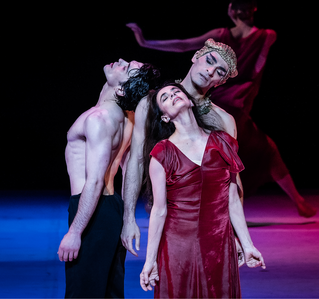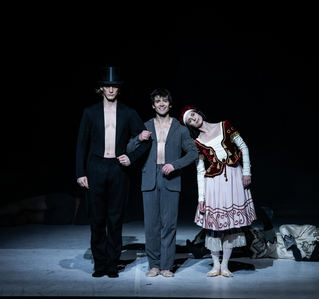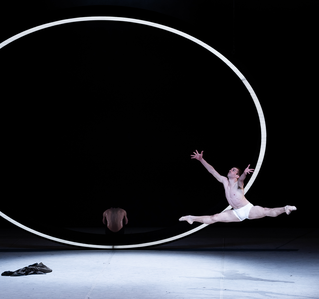Wed, Jun. 11, 2025, 7.30 pm - 10.00 pm | Main Stage
Ballet by John Neumeier
Nijinsky
Introduction at 6.50 pm (only on June 11)
"Nijinsky's life can be summarized easily: ten years of growing, ten years of learning, ten years of dancing, thirty years of darkness," biographer Richard Buckle once said. Vaslav Nijinsky, worshipped as the "God of Dance," left a lasting impression not only with his breathtaking jumps and charismatic presence but also with his choreographic work, which paved the way for modern dance. The phenomenon of Nijinsky has captivated John Neumeier since his youth. His ballet “Nijinsky”, premiered in 2000, portrays a life of extremes: Nijinsky in the spotlight as a star of the Ballets Russes, the world-renowned company under Serge Diaghilev, as well as in madness, in the shadows of his doubts and fears. John Neumeier conjures up some of the greatest roles of this unique artist, such as the Golden Slave, Petrushka, or the Faun. In contrast, the second act deals with Nijinsky's inner struggles. Under the powerful influence of Dmitri Shostakovich’s 11th Symphony, dark visions of the First World War unfold, along with the challenges that ultimately led Nijinsky to psychiatric care. John Neumeier creates a compelling tribute to Vaslav Nijinsky, whose genius is inseparably linked to his demons.
Music: Frédéric Chopin, Robert Schumann, Nikolai Rimsky-Korsakov, Dmitri Shostakovich
Choreography, Set and Costumes: John Neumeier
based partly on original sketches by Léon Bakst and Alexandre Benois
2 hours 30 minutes | 1 intermission
Part 1: 65 minutes, Part 2: 60 minutes
WORLD PREMIERE:
The Hamburg Ballet, Hamburg, July 2, 2000
ORIGINAL CAST:
Vaslav Nijinsky: Jirí Bubenícek
Romola Nijinsky: Anna Polikarpova
Bronislava Nijinska: Elizabeth Loscavio
Stanislav Nijinsky: Yukichi Hattori
Serge Diaghilev: Ivan Urban
Eleonora Bereda: Joëlle Boulogne
Thomas Nijinsky: Carsten Jung
The Ballerina, Tamara Karsavina: Heather Jurgensen
The new dancer, Leonid Massine: Guido Warsany
Nijinsky - The Dancer:
as Arlequin in "Carnaval": Alexandre Riabko
as the spirit of the rose in "Le Spectre de la rose": Alexandre Riabko
as the Golden Slave in "Sheherazade": Otto Bubenícek
as the Young Man in "Jeux": Guido Warsany
as the Faun in "L'Après-midi d'un faune": Otto Bubenícek
as Petrushka in "Petrushka": Lloyd Riggins
ON TOUR:
2001 Hanover 2002 Copenhagen, Baden-Baden 2003 Hong Kong, Madrid, Paris, St. Petersburg 2004 New York, Orange County (CA), Reggio Emilia, Washington 2005 Tokyo 2009 Monte-Carlo 2011 Stuttgart 2012 Beijing, Shanghai, Brisbaine 2013 Chicago, San Francisco 2017 Baden-Baden 2018 Tokyo 2020 Macao 2025 Baden-Baden
IN THE REPERTORY:
Semperoper Ballett
The Australian Ballet
The National Ballet of Canada
On January 19, 1919
at five o'clock in the afternoon in a ballroom of the Suvretta House Hotel in St. Moritz, Switzerland, Vaslav Nijinsky danced publicly for the last time. He called this performance his "Wedding with God".
My ballet "Nijinsky" begins with a realistic recreation of this situation. The choreography which follows, however, visualizes his thoughts, memories and hallucinations during this last performance.
PART I
Prompted by the imagined appearance of his former mentor, impresario and lover, Serge de Diaghilev, Nijinsky recalls images of his sensational career with the Ballets Russes.
Dancers, as aspects of his personality, perform fragments from his most famous roles.
"Harlequin", the Poet in "Les Sylphides", the Golden Slave in "Sheherazade" and the "Spectre de la rose" merge and mingle with characters from his private life.
His Sister Bronislava,later a choreographer, his older Brother Stanislav, trained also to be a dancer - but marked from childhood by signs of madness, and his Mother, the dancer Eleonora Bereda, who along with his Father Thomas were the children's first teachers, also appear in his dreamlike fantasy.
In another scene of the ballet, Nijinsky remembers his search for a new choreographic language. His experiments with movement result in his own original ballets "L'Après-midi d'un Faune", "Jeux", "Le Sacre du printemps" and later "Till Eulenspiegel".
A woman in red, Romola de Pulsky who will later become Nijinsky's wife, criss-crosses his confused recollections.
He relives their first encounter on a ship to South America and their abrupt marriage - an event causing the ultimate break with Diaghilev and the Ballets Russes.
PART II
Nijinsky's madness drives him more and more inside himself.
Memories of Childhood, Family, School, and the Mariinsky Theatre blend with nightmare visions of World War I - and his wife's infidelity.
The scandalous premiere of his ballet "Le Sacre de printemps" appears juxtaposed with the brutality of World War I and his brother Stanislav's death.
Romola is with him through difficult and bad times.
In Nijinsky’s eyes, it is the world around him - not "Nijinsky" that has gone mad…
The Suvretta House performance and my ballet end with Nijinsky's last dance - the War.
J.N.
LIST OF MUSIC
FRÉDÉRIC CHOPIN
Prélude No. 20
ROBERT SCHUMANN
"Faschingsschwank aus Wien", op. 26, 1st movement
NIKOLAI RIMSKY-KORSAKOV
"Sheherazade", op. 35, 1st, 3rd and 4th movement
DMITRI SHOSTAKOVICH
Sonata for Viola and Piano, op. 147, 3rd movement
Symphony No. 11 G minor, "The Year 1905", op. 103
The program (currently not available) and the DVD are available in our online shop



















